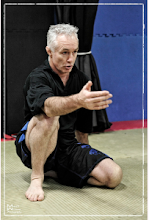
In the course of teaching martial arts, I have come across and developed many different training/teaching models. One of the ones I really liked, is what I call the Hourglass Training Model. I have also called this the ‘Five ways to catch a fish and one way to cook it’ model.
The most common model of teaching a technique is to instruct the student in one angle or position to apply the technique from, and then add variations on the technique, based on how the opponent reacts to it (Eg: if the opponent does this, then we do that, if he does that, then we do this, etc). In other words – teach the person one way to catch a fish and five ways to cook it.
The Hourglass Model embodies a very different approach. The idea goes like this:
I first instruct the student in a variety of ways to get into the technique, from as many positions and angles as are viable – and only emphasize the one finish to the move. This way I increase the chances of the student getting an opportunity n sparring to actually try the technique. Four different ways into the start of the technique means it becomes four times more likely that the opportunity will come up to at least, try the move. Once I see the student ‘hitting’ the move regularly on the mat, it then becomes time to show him/her the various variations on the finish (depending on how the opponent reacts). So the Hourglass Model puts the focus on increasing the students chances/opportunities to try the technique/move in sparring by increasing the amount of ‘entries’ or ‘ways in’ to the technique/move – rather than increasing the number of ways to ‘finish’ the technique/move. Hence the name ‘Hourglass’ – lots of ways in – before we emphasize lots of ways out (variations on finish). That is – we have now taught the student fie ways to catch a fish and one way to cook it. This will keep you fed, when it comes right down to survival. More ways to cook the fish – is just a luxury; ot necessary during the survival stage.
The more usual model is: one way in to the move – and lots of ways out (variations on finish); I call this the showerhead model. The big problem with the showerhead model is that if the student knows half a dozen variations on the finish part of the move/strategy – but he/she can’t even get a chance to try it in sparring – then ultimately, they won’t take ownership of the move at all – irrespective of how many variations of it they remember.
The Hourglass teaching model puts the emphasis on getting the student to the starting-line as many times as possible in the course of grappling/sparring. The more ways the student has in to the beginning of the technique, the greater the chances are that they will have the opportunity to try the technique. Ultimately, the more opportunities they have to try the technique, the more likely it becomes that they will be successful with it. The instructor has many roles, but one very important one is to create environments and opportunities for the student to experience success rather than failure. It’s all about success.
An example - the X-guard sweeps:
In utilizing showerhead model the instructor would teach the four or five main sweeps that the student can do from the X-Guard. The problem though, is if the student can’t even get to establish the X-Guard on the mat during wrestling, then the sweeps become purely academic. The student will not master any of them.
In utilizing the Hourglass model the instructor would teach the student four or five ways to establish the X-Guard in the normal course of wrestling. Once the instructor sees the student actually succeeding in establishing the X-Guard with regularity, he then teaches the student the four or five sweeps from there.
I trust this has you thinking,
best wishes
JBW
Subscribe by Email
Follow Updates Articles from This Blog via Email





















No Comments